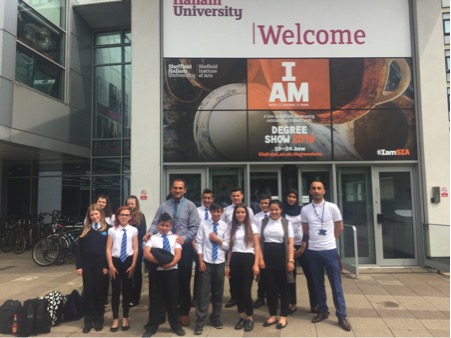Roma and non-Roma singing ensemble work, learning Roma repertoire. Using youtube for home learning.
The aims of this project were
- To encourage the Roma community to share something they love doing and are good at, to celebrate the 'hidden talents' of Roma pupils not often accessible in the everyday curriculum, to give them a chance to excel, display their culture to the rest of the school;
- To allow the opportunity for non-Roma pupils to be part of this sharing experience by learning another language via song and a little bit about Roma culture through interpretation of the lyrics;
- To encourage parents, whatever their ethnic background, to come into school and share this experience with them and show support for their child;
- To work collaboratively with another local school;
- To trial a model of working to share with other colleagues; and
- To encourage more musical activity in school, especially since music and singing are so important in the Roma community; celebrating their music is a way for everyone else in the school to recognise and value their heritage.

What is the context of the work?
Hinde House Secondary School ( http://www.hindehouse.net ) was purpose built in 2005 and is located in the North East of Sheffield. It is one half of Hinde House 3-16 School which opened in 2002 as the first public sector 'through school' in the country. Hinde House 3-16 School became an Academy in July 2013 and formed a Multi Academy Trust with other local schools in March 2014. The school has a large percentage of Roma students (around 20%). This is a relatively stable community group, as these Roma families have chosen to settle in this area of Sheffield.
The Roma Singing Project involved 30 students from School Years 7 to 9, comprising 15 Roma students and 15 from other backgrounds and cultures. This was a pilot project to explore ways in which aspects of the Roma culture could be shared, celebrated and valued in the school context, with a view to it playing a part in stimulating more interest in music in a school where there is a perceived need to develop the profile of music education in the curriculum.
The project was supported and funded by Sheffield Music Hub ( http://www.sheffieldmusichub.org ) who is keen to help raise the profile of music within and beyond the curriculum in this school. They continue to work closely with senior leaders in the school to look at strategies for nurturing this provision.
What is the content of the work?
The process began by working with the local Roma community to identify a range of songs which are seen as important in their culture and which would be appropriate for singing in a school setting. The staff found that most of the Roma students knew the songs already and were happy to sing them in school. They sang along enthusiastically to YouTube versions before moving on to working with solo guitar accompaniment. The staff reported that it was particularly gratifying to see the boys willing and able to lead the singing.
What are the key features of the teaching and learning approach?
This is an oral singing tradition, so although words were provided which students could download from the school intranet, the emphasis was on students learning by listening to the songs on YouTube at home [links?]. The Roma students provided a strong confident vocal foundation and took the lead in singing solo verses. Most were reported to have sung well already, but the singing leader introduced them to the concept of vocal warmups, which improved the quality of the singing further. The singing sessions culminated in two concerts—one in school and one at an EAL conference at Sheffield Hallam University ( http://www.hindehouse.net/blog/conference_choir.asp ). For the non-Roma students, this initiative was seen as providing some valuable insights into another culture, as well as the opportunity to sing in another language. The Roma students learnt about how singing is developed and performed in a typical school based 'choral' framework.
How is the work being reviewed?
There is a comprehensive Evaluation Report entitled 'Coming into their own': an evaluation of the Singing in Roma Communities project which is available for free download as a PDF from the Inspire-music website.
What are the positive outcomes for children/young people – are they some or all of musical, social, personal, educational - how and when can they be identified?
This project is seen to help Roma students to develop their teamwork, co-operation, interpersonal skills and relationships with others in a formal school environment. This is achieved by tapping into a project which has helped them to celebrate aspects of their culture. Teachers noted that this had a positive effect on their mood regulation and well-being, especially for some students who were finding it hard to integrate into an unfamiliar cultural setting.
Also, musically, it gave them confidence in performing in an ensemble and helped them develop their singing skills in terms of technique and expressive qualities.
What are the key features of teacher/leader behaviour that are enabling those positive outcomes?
The teachers leading such a project need to be confident and accurate singers. They need to have a good 'ear', so that accompaniments can be derived from listening to recordings of songs. They need to be sensitive to the culture[s] that they are accessing and to choose material which is musically and age appropriate for the students which whom they are working. The communication with pupils needs to be through the language of music, since many Roma students may struggle with instructions in English. Teachers need to be prepared to harness the power of Roma students as peer (co-)teachers as part of the process and accept that many Roma students may not be used to the protocols and conventions of working in formal classroom settings.
What are the key features of context, content and activities that are enabling those positive outcomes?
The project's major finding was the potential of music as a positive tool for integration. Being perceived by their peers to excel visibly boosted Roma students' self-confidence and pride in their Roma identity, particularly for individuals who often struggled with the school's academic curriculum. The project generated a wave of enthusiasm among staff and non-Roma students alike for musical heritage projects in future.
An understanding of the intangible cultural heritage of different communities helps with intercultural dialogue, and encourages mutual respect for other ways of life.
…The importance of intangible cultural heritage is not the cultural manifestation itself but rather the wealth of knowledge and skills that is transmitted through it from one generation to the next. The social and economic value of this transmission of knowledge is relevant for minority groups and for mainstream social groups within a State …
The culture of the Roma, like other cultures, is dynamic, responsive to changes outside the Roma community. Romani 'literacies' have evolved within social media networks, and opportunities for global communication have established a vigorous and digitally sophisticated international Roma community. In the Roma that the staff encountered, they were initially taken aback to discover the value placed on YouTube as a cultural resource. But it gradually emerged that on a very small and particular scale, the project findings reflected a much wider phenomenon. Song, accompanied by music and dance, remains integral, as it has traditionally, to Roma family and social life, but the internet has given them a global reach, and the potential of a global voice.
This project can be seen as a contribution to a much wider undertaking across the north-east of Sheffield to encourage communities of all cultures and histories to live and work constructively with one another towards acceptance and accommodation of difference within a sense of common purpose and commitment.
From conversations with Roma participants, it was clear that some songs continued to honour the endurance of the Roma under persecution. But today's Roma are leaving traditional 'gypsy' stereotypes and their negative connotations behind. In Romani, and in their adopted languages, they are incorporating the popular musical culture of the internet in their lyrics, melodies and production to promote a new global, contemporary musical identity expressing the aspirations of the current generation. Research in Doncaster and Sheffield made clear that, for young people particularly, the potential of popular music as an international language is undeniable. Schools need to mobilise this rich and accessible cultural resource.
How replicable or adaptable is it?
In terms of resourcing, the requirements are straightforward. Access to suitable YouTube clips for learning the songs aurally, plus a teacher who is able to devise appropriate accompaniments to be played by teacher and/or students. Suitable instruments would include keyboards, guitars, hand percussion and accordion. The class should also have a group of Roma students who can help with leading the singing sessions.
With a careful selection of songs, this work can be adapted to make it suitable for upper primary and all secondary levels.
The model could be adapted to working with other distinct cultural heritages according to the school community.
Resources
- Roma project evaluation document: https://drive.google.com/file/d/0Byqrw9DGETAFbHVCNWZPdmdBU1E/view?usp=sharing
- The following website was useful for learning more about Roma culture, dances and songs https://gypsylyrics.net
